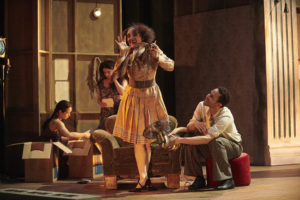You have no items in your cart. Want to get some nice things?
Go shopping
As the show begins, a dancer stops the clock on stage, so that the hands are frozen on 7.09pm. From there, the audience is catapulted into a non-narrative time-suspended vortex of loss, death, and nostalgia, mixed up with hilarious absurdity. Alan Lucien Øyen’s Bon Voyage Bob… is so imbued with the memory and reverence of Pina Bausch that it sometimes struggles to stand on its own two feet – it dwells (too much?) on the sense of absence, without offering much “substance”.
At the core of the piece is the deliberate and obsessive juxtaposition of life and death (reminiscent of what one sees in Alfonso Cuarón’s Roma). However, while in Roma the pathos is generated by the prolonged holding back of emotions, and their subsequent release all in one go, Bon Voyage Bob… throws at the audience one stark contrast after the other, seemingly without a cohesive plan.
From a funeral carer laughing out loud at a woman’s suicidal brother, to an old lady gloriously celebrating the beauty of old age (a bit like in Pirandello’s essay On humour), to a man writing “I’m still here”, only to be used by a squad of men to wipe it off. Particularly emblematic is the moment when we play Hangman: the audience shouts out letters, is puzzled, tries to guess and enjoy the game, but in reality what’s being revealed is a dead man on a gibbet. Similarly, Bon Voyage Bob… feels like a grotesque meditation on death as our common destiny, interspersed with moments of dark humour and lacerating laughter. One for all, Nazareth Panadero can be outrageously funny and frivolous, but also deadly serious, threading death into the weave of everyday life.
The piece features more dance than Dimitri Papaioannou’s Since She, the other full-length work newly commissioned by the Tanztheater Wuppertal company. The moments of dance have the quality of Russell Maliphant’s vaporous pieces, though one wishes they were more dynamically integrated into the acted bits. There are a few highlights, where the contrast between acting and dancing emerges as fruitful, for instance in a spoken-and-danced duet that is both a confrontation and a moment of intimacy.
Length-wise, the show is in-line with Bausch’s extended routines. But already challenging in content, the length of the piece (three hours and a half with an interval) creates a deflating effect. A few members of the audience left halfway-through, which was a shame. In the second act, though, things do slow down considerably: the sequences drift more and more apart from each other, ending up in a pastiche of snapshots with questionable meaning. While the first half does have some inspiring moments, as the work proceeds the experience is not an entirely positive one for the audience.
One strength that must be acknowledged is the mesmerising set design by Alex Eales. By keeping twisting slowly, solemnly, scene after scene, it opens up endless possibilities and gives an infinity of backdrops to a limited stage.
The empty chair at the end stands clearly for Pina’s absence, but one wonders whether instead of making her memory a daunting one, it might have been better for the company to move onto more productive, explorative, and stimulating work.
Bon Voyage Bob… played at Sadler’s Wells 22 – 25 February 2019.
About Anna Zanetti
Anna graduated from the University of Oxford with a BA (Hons) in Classics, specialising in Literature, Aesthetics and Ancient Art. Currently based in London, she has eclectic interests, including avant-garde art, cycling, reading, contemporary dance, opera, (watching) rugby, and anything to do with Latin. She writes for The Oxford Culture Review, Theatre Bubble and A Younger Theatre, as well as keeping a personal blog about arts and culture.
- Web |
- More Posts(10)




